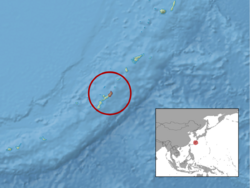Biology:Muennink's spiny rat
| Muennink's spiny rat | |
|---|---|
| Scientific classification | |
| Domain: | Eukaryota |
| Kingdom: | Animalia |
| Phylum: | Chordata |
| Class: | Mammalia |
| Order: | Rodentia |
| Family: | Muridae |
| Genus: | Tokudaia |
| Species: | T. muenninki
|
| Binomial name | |
| Tokudaia muenninki (Johnson, 1946)
| |

| |
Muennink's spiny rat or Okinawa spiny rat (Tokudaia muenninki, Japanese: オキナワトゲネズミ, romanized: Okinawa togenezumi or 沖縄棘鼠) is a species of rodent in the family Muridae.[2] Endemic to Okinawa Island, Japan , its natural habitat is subtropical moist broadleaf forest. The karyotype has 2n = 44.[2] Its sex chromosomes are abnormally large, while the other two species in Tokudaia have lost their Y chromosome.[3] It is found only on the northern part (Yanbaru area) of the island, above 300 m,[1] and is thought to inhabit an area of less than 3 km2.[4]
The head and body are up to 7 inches long with a 5-inch tail. They weigh up to 7 ounces. They have a short thick body and dense fur, consisting of fine hairs and coarse, grooved spines (hence the common name “spiny rat”). The fur is brownish above and grayish white below with a faint orange tinge. The spines on the animal's back are black throughout while the spines underneath are usually white with a reddish-brown tip. The spines cover the body except for the regions around the mouth, ears, feet and tail. The tail is bi-colored for its entire length.[5]
The species is threatened by deforestation, predation by feral cats and introduced mongooses, and competition with introduced black rats.[1] In March 2008, the first wild specimen in over 30 years was caught in the northern part of Okinawa.[6]
References
- ↑ 1.0 1.1 1.2 Ishii, N. (2016). "Tokudaia muenninki". IUCN Red List of Threatened Species 2016: e.T21972A22409515. doi:10.2305/IUCN.UK.2016-1.RLTS.T21972A22409515.en. https://www.iucnredlist.org/species/21972/22409515. Retrieved 13 November 2021.
- ↑ 2.0 2.1 Musser, G.G.; Carleton, M.D. (2005). "Superfamily Muroidea". in Wilson, D.E.; Reeder, D.M. Mammal Species of the World: A Taxonomic and Geographic Reference (3rd ed.). Johns Hopkins University Press. pp. 1512–1513. ISBN 978-0-8018-8221-0. OCLC 62265494. http://www.departments.bucknell.edu/biology/resources/msw3/browse.asp?id=13001849.
- ↑ Murata, C.; Yamada, F.; Kawauchi, N.; Matsuda, Y.; Kuroiwa, A. (2011-12-24). "The Y chromosome of the Okinawa spiny rat, Tokudaia muenninki, was rescued through fusion with an autosome". Chromosome Research 20 (1): 111–125. doi:10.1007/s10577-011-9268-6. PMID 22198613.

- ↑ "Okinawa Spiny Rat". http://www.edgeofexistence.org/species/okinawa-spiny-rat/.
- ↑ "EDGE of Existence". http://www.edgeofexistence.org/mammals/species_info.php?id=51.
- ↑ "幻のネズミ、30年ぶり捕獲 沖縄北部の絶滅危惧種". http://www.excite.co.jp/News/society/20080305195620/Kyodo_OT_CO2008030501000840.html.
Wikidata ☰ Q638140 entry
 |


